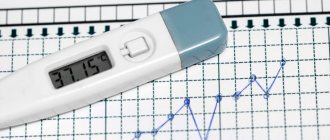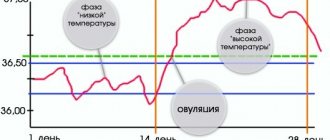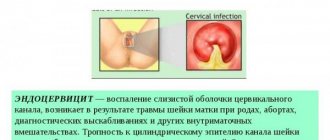Basal temperature 37 and above: what does this mean?
If a woman monitors her basal temperature, she can learn how well her reproductive system is functioning.
Over time, she will learn to determine the time of ovulation and menstruation, and will be able to detect pregnancy and inflammation. At first glance, the method seems inconvenient. However, a woman, as a rule, very quickly gets used to measuring her temperature in this way every morning. After months of research and seeing that the method works, she begins to trust it.
So let's figure out how it works. The menstrual cycle is divided into two periods, separated by ovulation. Before this, there is a high level of estrogen, which ensures the growth of follicles. These hormones lower basal temperature. After ovulation, the corpus luteum secretes progesterone. This hormone increases the temperature. When its level decreases, menstruation begins. Therefore, in the first stage the temperature is low, and in the second stage it is high. The difference between their average values should be more than 0.4 degrees.
In the second phase, the basal temperature is usually 37 and above, and in the first it stays below this level. However, other indicators do not always indicate pathology, but may be a variant of the norm. A basal temperature of 37 or higher should last for two weeks. The duration of this period may vary by two days. If less than 10 days have passed and the temperature is below normal, then the corpus luteum may be insufficient. In this situation, pregnancy becomes problematic.
In this case, your doctor will order you to check your progesterone levels and prescribe you gestagens, mainly Duphaston or Utrozhestan. If pregnancy occurs while taking these medications, then use should be continued until week 20 to avoid miscarriage.
A basal temperature of 37.2 degrees is usually highest in the second phase. Too high values may indicate inflammation of the appendages. Although there are cases when it rose to 38, and this was a variant of the norm. It is also important to consider your overall body temperature, which increases with the flu and other illnesses.
A basal temperature of 37 or slightly lower is observed several days before menstruation, usually it lasts about three days. This is due to a decrease in progesterone levels.
A one-day decrease in temperature 7-10 days after ovulation is called subsidence of implantation. At this stage, the embryo is introduced into the endometrium. The decrease in temperature is explained by the fact that there is a jump in estrogen levels, and on the other hand, already during this period the production of progesterone decreases.
A basal temperature of 37.4, absence of menstruation and a duration of the second phase of more than 18 days may indicate pregnancy. The temperature should remain at this level for the first 4 months. The temperature can be lower, but must exceed 37 degrees. If its values are lower, then you can suspect a threat of miscarriage due to a lack of progesterone. In this case, an analysis is carried out to determine its level. If concerns are confirmed, gestagens are prescribed.
If the basal temperature drops before menstruation and rises during it, this may indicate inflammation of the uterine mucosa. Typically, during the monthly cycle, the temperature should gradually decrease to the minimum values of the first phase.
If the basal temperature of 37 with slight fluctuations remains throughout the entire cycle, this may mean that there is an increased amount of prolactin. It blocks the release of LH and FSH and ovulation does not occur. Pregnancy is not possible during this cycle. If the temperature remains high before and during unusual periods, and then drops sharply after them, then an early miscarriage has probably occurred. However, only a gynecologist can decipher the data obtained.
So, a basal temperature of 37 degrees or higher should be in the second phase and in the first months of pregnancy. During menstruation and before ovulation, such values are pathological.
basal temperature 37.4
The onset of pregnancy was a shock for me, I’m 37 years old, I recently visited a gynecologist two months ago, looked at it, said there was replenishment, presumably adnexitis and the symptoms were chronic! He also noted a high probability of endometriosis, said that I would no longer be able to get pregnant and referred me to Ultrasound! I didn’t get an ultrasound because I was sick, and it was a waste of time to travel 30 km, and on you... a week before my period, spotting started, a little, but I thought M, masolo was starting to turn brown the day and a little the next, a week passed, Is there something wrong











